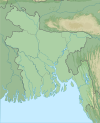Nijhum Dwip National Park
Nijhum Dweep National Park covers approximately 16,352 ha (163.52 km) of mangrove forests biome. The land was declared as national park by the Bangladesh government on 8 April 2001 under the Wildlife Act of 1974.
The waters nearby was declared as the Nijhum Dwip Marine Protected Area in 2019.
Location
It is located 2 km (1.2 mi) south west of Hatiya. The Nijhum Dwip comprises four to five small islands namely Char Osman, Char Kamla, Char Muri and Bellar Char islands. The area is mainly composed of Intertidal mudflats and sand flats. It has a 20 km (12 mi) sandy beach and grassland. The climate is generally humid and warm.
Plants and Animals
Flora
The general walk in the forest is not easy due to muddy soil and pneumatophores of Sonneratia apetala (Keora) and Avicennia alba (Baine) trees. About 152 plant species belonging to 56 families have been recorded. Seven plant species recorded as rare are Bruguiera gymnorhiza (kakra), Derris trifoliata, Diospyros blancoi, Tamarix gallica, Heliotropium currasavicum, Typha elephentanea, Sarcolobus carinatus.
Fauna
The majority of animals found are spotted deer, which can be seen in plenty here. Other animals seen here are small-clawed otter, golden jackal,Water buffalo monitor lizard, fishing cat, turtles and dolphins. The park is notable because it contains world's largest population of Indian skimmer birds. More than 100 species of migratory and resident birds are recorded in the national park. The water bodies are a major busiest airport for migratory birds. Globally threatened birds like Spoon-billed sandpiper, Asian Dowitcher, Nordmann's greenshank, Spotted redshank, Goliath Heron and Indian Skimmers are seen here. The tributaries around the islands are abode to Ganges dolphin, Indo-Pacific humpback dolphin, Indo-Pacific finless porpoise, and Irrawaddy dolphin. Whales have been spotted occasionally. The channels are very rich in micro benthos and other invertebrates.
Human Settlement
There are scanty human habitation inside the National park area. There are 8 thousand inhabitants with fishing and cultivation as major livelihood
Registered forest villagers have certain rights within the reserve. This includes wood collection for fuel and building materials, hunting, betel leaf production, grazing of livestock, harvesting of other forest products, and limited agriculture in allocated land.
See also
References
- ^ "Nijhum Dwip National Park". Nishogo. Retrieved 21 November 2019.
- ^ Wildlife Conservation Society, 2019, "King of Fish," Endangered Dolphins, Sharks, Turtles Protected in Sweeping New Marine Protected Area
- ^ "Plant biodiversity of Nijhum Dweep (Island)". June 2014. Retrieved 21 November 2019.
- ^ "Biodiversity of Nijhum Dweep National Park". Natural History Book Service. February 2015. Retrieved 21 November 2019.
- ^ "Nijhum Dweep 'busiest airport' of migratory birds". The Daily Star. 4 February 2012. Retrieved 21 November 2019.
